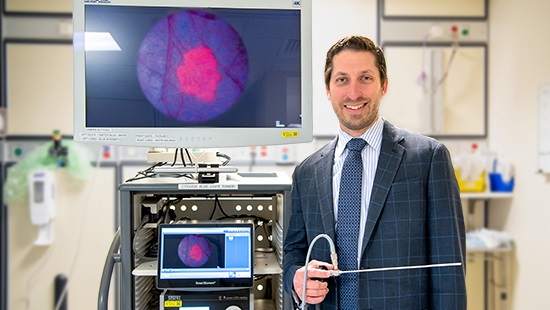Cancer
Bladder Cancer Treatment

If you have been diagnosed with bladder cancer, there are many different options for treatment.
Blue Light Cystoscopy
Blue Light Cystoscopy with Cysview® is an innovative tool used to allow better visualization of bladder tumors. Cysview® is an imaging solution instilled within the bladder and preferentially absorbed by cancer cells. During cystoscopy an ultraviolet light is utilized to highlight cancer cells, which fluoresce with color.
Minimally Invasive Surgery
The daVinci Robotic Surgical System is used for minimally invasive surgery.
Transurethral Resection of Bladder Tumor (TURBT)
TURBT is the first step in both the diagnosis and treatment of bladder cancer. This surgery utilizes a scope with an electrocautery loop to resect, cut or scrape the tumor out of the bladder. This is also the most common treatment for early-stage or superficial (non-muscle invasive) bladder cancers. Most patients have superficial cancer when they are first diagnosed, so this is usually their first treatment. The surgery is done using an instrument put up the urethra, so it does not require cutting into the abdomen.
Intravesical Therapy
Intravesical therapy is used after transurethral resection of bladder tumor (TURBT) for non-invasive or minimally invasive bladder cancers to help keep the cancer from coming back. A live bacteria called BCG (Bacillus Calmette-Guérin) is injected into the bladder to induce an immune response and prevent recurrences of cancer. Various chemotherapy agents can also be placed within the bladder to directly kill cancer cells and prevent tumor recurrences.
Radical Cystectomy
This surgery involves the removal of the bladder. The lymph nodes and other sexual organs (including the prostate and seminal vesicles in men and the uterus, fallopian tubes, ovaries, and part of the vagina in women) are also removed. Radical cystectomy can be performed either via a traditional open surgery or robotically. A urinary diversion will provide the body a means to potentially store and eliminate urine once the bladder has been removed.
- Ileal conduit – This is the most common and simplest urinary diversion. A segment of small intestines is used to connect the ureters to the outside of the body through an opening in the abdominal wall called a stoma. This is covered with a bag that collects continuously draining urine.
- Continent catheterizable reservoir – This procedure involves creation of an internal pouch using a portion of the intestines in order to store urine. The urine is emptied by inserting a catheter through a small opening in the skin near the navel.
- Neobladder – This procedure creates a "new" bladder from a segment of the intestines. This new bladder is connect to the urethra in order to pass urine normally. This surgery necessitates having to re-learn how to urinate. In addition, many patients have to occasionally catheterize the neobladder in order to facilitate bladder emptying.
Chemotherapy
Used to treat a variety of cancer types, chemotherapy is an important tool in the treatment of advanced bladder cancer that has either invaded deeply into the wall of the bladder or spread to other sites. Chemotherapy is instilled intravenously and can be administered either before or after surgery or can be used in combination with radiation.
Radiation Therapy
This treatment be sometimes used in combination with intravenous chemotherapy (trimodality therapy) in select patients with invasive cancer.
Find a physician for urology and bladder cancer treatment.
